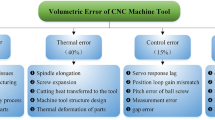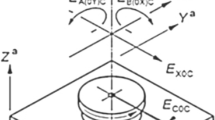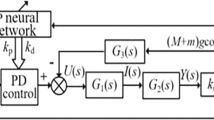Abstract
Machining robots have major advantages over cartesian machine tools because of their flexibility, their ability to reach inaccessible areas on a complex part, and their important workspace. However, their lack of rigidity and precision is still a limit for precision tasks. Innovations and design optimization of robotic structure, links, and power transmission allow robot manufacturers to propose business solutions for machining applications. Beyond accuracy problems, it is also necessary to quantify the vibration phenomena that may affect, as in machine tools, the quality of machined parts and the tools and spindle lifespan. These vibrations occurred at specific machining conditions depending on robot and spindle dynamic properties. The robot’s posture evolved significantly in its workspace and induces dynamic’s changes observed at the tool tip that in turn impact the stability of the machining process. The objective of this paper is to quantify the dynamic behavior’s variation of an ABB IRB 6660 robot equipped with a high-speed machining (HSM) spindle in its workspace and analyze the consequences in terms of machining stability. Through an experimental modal characterization, significant variability of modal parameters is observed at the tool tip and impacts the stability of machining. The results show that an adjustment of the cutting conditions must accompany the change of robot posture during machining to ensure stability.
Similar content being viewed by others
References
Chen Y, Dong F (2013) Robot machining: recent development and future research issues. Int J Adv Manuf Technol 66(9-12):1489–1497
Pan Z, Zhang H, Zhu Z, Wang J (2006) Chatter analysis of robotic machining process. J Mater Process Technol 173(3):301–309
Tobias SA, Fishwick W (1958) The chatter of lathe tools under orthogonal cutting conditions. ASME, Trans 80(5):1079–1088
Tlusty J, Polacek M (1963) The stability of the machine tool against self-excited vibration in machining. ASME Int Res Production 1:465–474
Abele E, Weigold M, Rothenbücher S (2007) Modeling and identification of an industrial robot for machining applications. CIRP Ann Manuf Technol 56(1):387–390
Olabi A, Bearee R, Nyiri E, Gibaru O (March 2010) Enhanced trajectory planning for machining with industrial six-axis robots. In: IEEE international conference on industrial technology (ICIT), pp 500–506
Zhang H, Wang J, Zhang G, Gan Z, Pan Z, Cui H, Zhu Z (2005). In: Proceedings IEEE/ASME international conference on advanced intelligent mechatronics, 2005. pp 1127–1132
Coelho Reginaldo T, Rodella Hugo HT, Martins Vinícius F, Rossana Barba J (2011) An investigation into the use of industrial robots for machining soft and low density materials with hsm technique. J Braz Soc Mech Sci Eng 33:343–350
Altintaş Y (2000) Manufacturing Automation: Metal Cutting Mechanics, Machine Tool Vibrations, and CNC Design. Cambridge University Press
Bisu C-F, Cherif M, Gérard A, K’Nevez J-Y (2012) Dynamic behavior analysis for a six axis industrial machining robot, ArXiv e-prints
Altintaş Y, Weck M (2004) Chatter stability of metal cutting and grinding. CIRP Ann Manuf Technol 53(2):619–642
Özşahin O, Özgüven HN, Budak E (2010) Analysis and compensation of mass loading effect of accelerometers on tool point frf measurements for chatter stability predictions. Int J Mach Tools Manuf 50(6):585–589
Peeters B, Van der Auweraer H, Guillaume P, Leuridan J (2004) The polymax frequency-domain method: a new standard for modal parameter estimation Shock Vib 11(3-4): 395–409
Guillaume P, Verboven P, Vanlanduit S, Van der Auweraer H, Peeters B A poly-reference implementation of the least-squares complex frequency-domain estimator. In: proceedings of IMAC XXI, the International Modal Analysis Conference, Kissimmee (FL), USA, p 2003
Peeters B, Guillaume P, Van der Auweraer H, Cauberghe B, Verboven P, Leuridan J Automative and aerospace applications of the polymax modal parameter estimation method. In: proceedings of IMAC XXII, the International Modal Analysis Conference, Dearborn (MI)USA, p 2004
Mejri S, Gagnol V, Le T-P, Sabourin L, Ray P, Paultre P (2014) Analysis of machining robot configuration variation on tool tip frf measurements. In: XIX Symposium VISHNO, Aix en Provence, France
Liao YS, Young YC (1996) A new on-line spindle speed regulation strategy for chatter control. Int J Mach Tools Manuf 36(5):651–660
Cheng K (2009) Machining Dynamics - Fundamentals, Applications and Practices. Springer, London
Author information
Authors and Affiliations
Corresponding author
Rights and permissions
About this article
Cite this article
Mejri, S., Gagnol, V., Le, TP. et al. Dynamic characterization of machining robot and stability analysis. Int J Adv Manuf Technol 82, 351–359 (2016). https://doi.org/10.1007/s00170-015-7336-3
Received:
Accepted:
Published:
Issue Date:
DOI: https://doi.org/10.1007/s00170-015-7336-3




